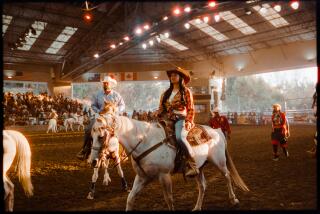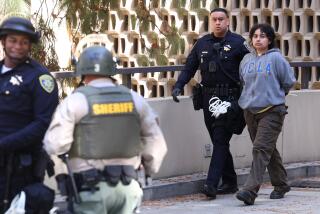A Pilgrimage of Black Pride
GREENSBORO, N.C. — Wearing white hard hats, 17 black youngsters from California listened in respectful silence as an African American museum curator led his first tour of a converted Woolworth’s store that was a key battleground in the civil rights revolution 44 years ago.
“This museum will show,” said Robert L. Haynes, motioning toward the building’s unfinished shell, “what it was like to have your existence not valued, to have your life considered meaningless. To be invisible.”
He described how four freshmen from nearby North Carolina Agricultural & Technical State University endured taunts, curses and worse to sit with whites at the Woolworth’s lunch counter until they were served.
“And when you go back to California,” Haynes said, “I want you to think what are the things you can change, that you can take courage in, and see a result.”
The California youngsters, most of them high school age, had come to North Carolina during Easter vacation in search of their cultural roots -- and, just maybe, a college education among their own race. Now they were mesmerized as they embraced a common history.
Said Michael Lee, an Oxnard ninth-grader, “I felt I was special.”
While other teenagers spent Easter break at shopping malls and amusement parks, these youngsters from Oakland and Fresno, Los Angeles and Sacramento journeyed 3,000 miles to tour campuses at nine historically black colleges and universities in North Carolina.
For the 15th straight spring, Irene and Bedford Pinkard from Oxnard led the April trip to colleges that offer students an alternative to the predominantly white campuses of California.
“There’s a nurturing at these black colleges: They take you from where you are and move you to where you need to be,” said Irene Pinkard, 60, a high school trustee and retired community college administrator.
She and her 73-year-old husband, a city councilman, were born in the South, have family there and still embrace that region’s strong sense of black community.
“Youngsters need to see African Americans in positions of leadership,” said Irene, the daughter of a Methodist minister. “They need to see there’s more to African American achievement than music and sports.”
The Pinkards’ annual tour reflects a heightened interest by blacks in the South, where the 2000 census showed nearly 700,000 African Americans had moved during the previous five years.
Enrollment at 105 historically black colleges and universities, mostly in the South, increased by 29% to 287,000 from 1976 to 2002. The United Negro College Fund’s research institute also reported that in 2002 about 29% of all African Americans who received bachelor’s degrees attended historically black campuses.
“Enrollment has been steadily increasing in light of the perceived hostility around affirmative action diversity at major institutions,” said M. Christopher Brown, the research institute’s executive director. “And people are now just beginning to recognize the quality of these programs.”
Increases have been particularly sharp among students from California, which now has the second-highest enrollment of all states at the 39 colleges that are members of the fund, Brown said.
They are drawn to black universities, many founded to educate freed slaves after the Civil War, by lower tuitions, flexible entrance requirements and low student-teacher ratios. And they want to spend time in an environment where they are not judged each day by the color of their skin.
Many applicants have never set foot on a college campus before, said Michael Lomax, president of Dillard University in New Orleans and president-designate of the United Negro College Fund. “And if we’ve developed a specialty,” he said, “it’s turning low-income, high-performing kids into college graduates.”
Wide-Ranging Group
The Pinkard group -- an array of students from families both prosperous and poor -- came together by word of mouth through family, friends and church connections. They ranged from an 11-year-old sixth-grader to three high school seniors. For the first time, boys outnumbered girls, 10 to seven.
Their parents are ministers, business owners, prison guards, criminal investigators, maintenance and officer workers, a social worker and a public transit train driver. Most paid a fee of $750 for airfare, ground transportation and main meals.
Some of the students had been to black colleges before and were eager to return. For Janea Odom, a junior at a suburban Sacramento high school, the trip was a fact-finding mission.
“My father doesn’t want me to go to a black college; he says the world’s of all races,” she said. “So what I’m asking on this trip is, how can a black college benefit me as a black woman?”
For seven days and nights, the California youngsters made the most of their Carolina adventure.
After a Saturday flight from Los Angeles, former Compton Community College administrator Janet Bowman, now an Asheville, N.C., resident and an old friend of Irene Pinkard, led the busload of students through an eventful Easter Sunday that climaxed with a circle of prayer and dinner at her home.
Bowman, author of a guide to America’s black colleges, took the group to an early service at an all-white church, where members first watched them warily, then welcomed them warmly and finally invited them to brunch. Bowman directed the youngsters’ bus to a historic Baptist college, Mars Hill, where she now teaches.
“A black man saved this college,” Bowman said. “They owed a bill, and he allowed himself to be held as collateral until the bill was paid.”
“He took one for the team,” quipped Jeremiah Penny, an Oxnard senior, cracking up the others.
Inside the Mars Hill library, a collage of photos on Bowman’s office door revealed a blunt message. Among those of “achieving black women” was National Security Advisor Condoleezza Rice.
“In high school her counselor told her she was not college material,” said Bowman, herself a coal miner’s daughter from West Virginia who earned a master’s degree from USC and a doctorate from UCLA.
The next day, another former Californian came through for the crew at the old Woolworth’s store in downtown Greensboro, when curator Haynes responded to Irene Pinkard’s persistent requests and agreed to open the International Civil Rights Center and Museum 10 months early.
It was the highlight of an extraordinary day of images at or near North Carolina A&T;, founded in 1890 as the Agricultural and Mechanics College for Colored People and now one of the largest black colleges in the nation and the top producer of African American engineers.
The tour drove up Harriett Tubman Street, and the visitors repeated softly the name of the former slave who dedicated her life to freeing others. The tour passed Alex Haley Hall, a dormitory named for the author of “Roots,” whose father attended in 1932. It passed the student offices, where former presidential candidate Jesse Jackson, a 1964 graduate who led civil rights demonstrations in Greensboro, had served.
It came to a science building where Challenger astronaut Ron McNair earned a physics degree with a 4.0 grade average. “Whoa, 4.0,” the youngsters said. It passed the Paul Robeson Professional Theater, where celebrated poet and best-selling author Maya Angelou sometimes speaks.
Then the tour rolled to a stop in front of an aging brick dormitory. There in 1969, student William Ernest Grimes “lost his life for the cause,” the guide said, when National Guardsmen shot M-15 bullets through a wall at protesting students. Dozens of large holes still pock the exterior. The dorm will be torn down this summer, but the wall will be preserved, the guide said.
“What I saw today,” said Rhyan Thomas, a senior at King Drew Magnet High School in Los Angeles, “really made me feel proud, how they embrace their history. And there are so many successful people coming out of here. Wow.”
For five more days, the students listened and learned. Dressed in Levis and sweatshirts, they laughed and sang and flirted. They scored well when the strict Irene popped quizzes each evening. During orientations, they asked questions about costs, scholarships and college specialties.
Some were impressed with the larger, fast-growing public universities that were studded with new red-brick buildings and generally required better grades and test scores for entry: a 2.5 grade average and 920 on the SAT for out-of-state A&T; applicants, for example.
Others preferred the slower, more comfortable environs of the small private colleges that seemed willing to do just about anything to admit a student, such as allowing a 2.0 grade average with no SAT minimum at tiny Shaw University in Raleigh.
Ears pricked up when a guide at Shaw told the story of benefactor Willie E. Gary, an attorney and cable television mogul who gave the college $10 million several years ago when it really needed it.
A member of a migrant farmworker family, Gary showed up desperate for a college education in 1968 with $10 to his name, the guide said. “We accepted Willie E. Gary like he was. And we waived the application fee.”
Winning Converts
In the end, at least three in the California group said they wanted to attend a black college.
Even before the trip, 17-year-old Rhyan had made that decision. She had already been admitted to three schools and was awaiting word from Howard University in Washington, D.C., perhaps the nation’s most prestigious historically black campus.
By the trip’s end she had applied at two more: North Carolina A&T;, which impressed her with its doctoral program in biology and its open pride in its past; and Shaw, founded in 1865, the oldest black college in the South.
Rhyan created a stir when Shaw admitted her within hours. She is now seeking a full scholarship of $14,882 a year.
“It just seems at a black college they’d be more focused on me,” said Rhyan, whose mother is a social worker and whose father works in construction.
For Anthony Robinson, a sophomore at El Segundo High School whose parents are government investigators, the tour was a valuable lesson.
“My teachers tell me I have the potential for A’s, but I’ve got to apply myself in class,” said the lanky 15-year-old. “And sometimes I forget what makes me special from white or Asian or Hispanic. So this was a positive reinforcement of that whole thing.”
The Pinkards began the trips in 1990 after escorting Irene’s son to Louisiana for a taste of Grambling State University. Since then, about 230 students have taken their tour and about three dozen have gone on to attend black colleges. “It’s great to be surrounded by so many black students who are goal-oriented,” said Cheryl Gilbreath, a former tour participant who is a pharmacy student at Howard.
“I realized I was in a box in Oxnard,” she said. “Here I still may be limited, but the box is bigger and the door that opens the box is unlocked. And when I get to that door, there’ll be no limitations on me.”










